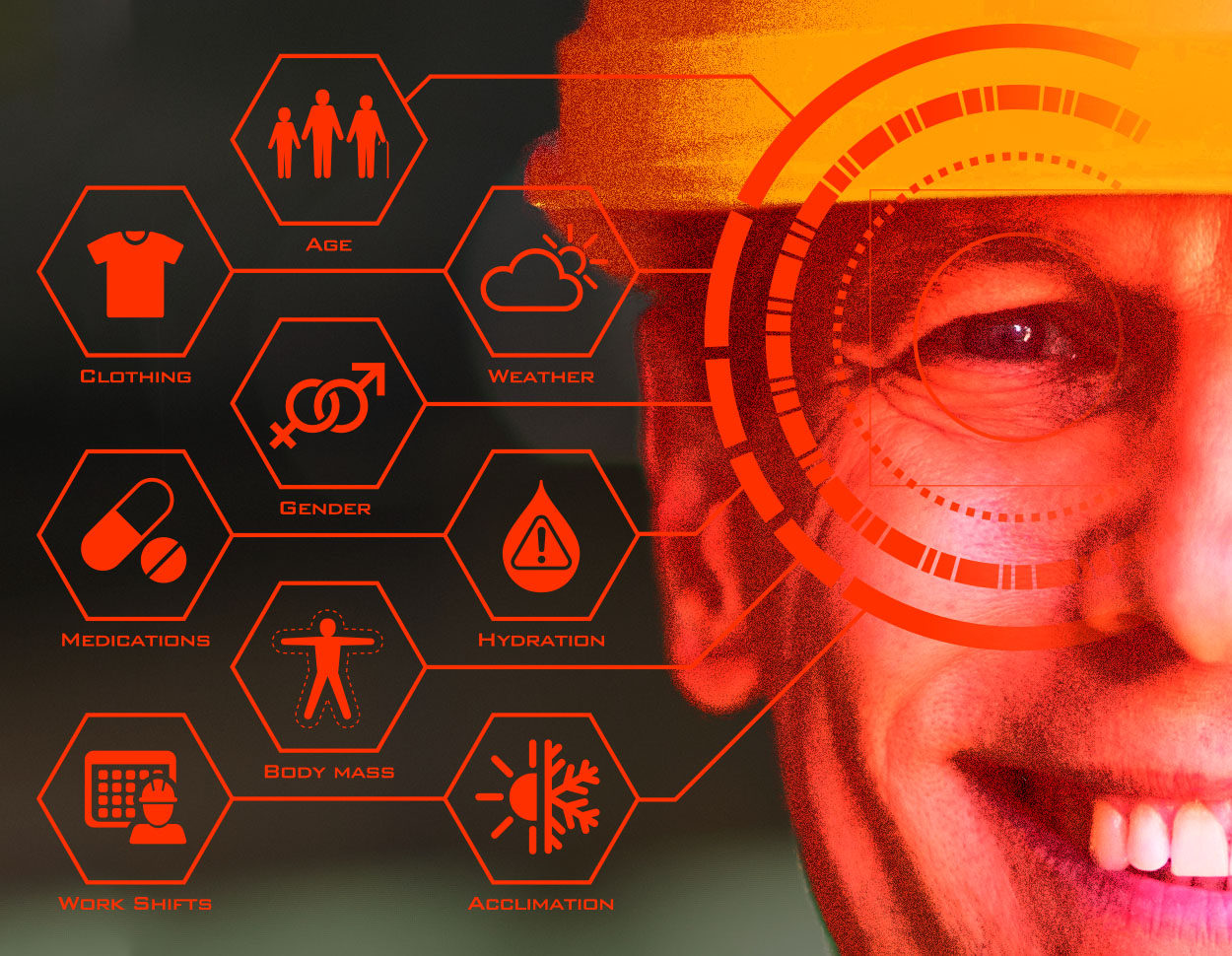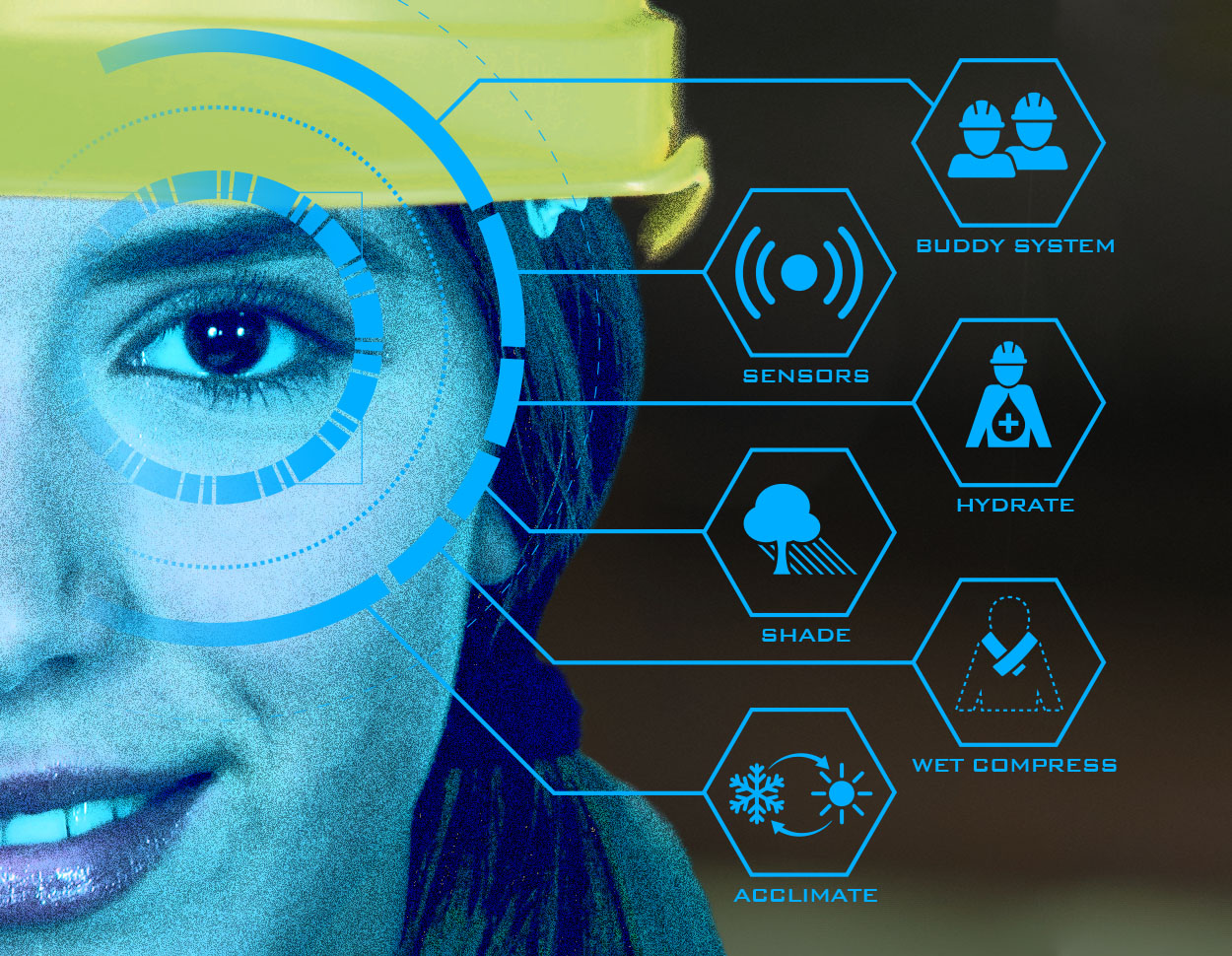EPRI Research Yields Valuable Insights on Managing Heat Stress in the Electric Power Industry
Los Angeles Department of Water and Power (LADWP) has incorporated insights from EPRI heat stress research into its employee safety training and heat illness prevention training for supervisors. “Crew members are more likely to relate to their safety training and implement safe work practices if materials are credible and relevant to their industry,” said LADWP Industrial Hygienist Marc Hendon. “EPRI offers this relevance, and its research reinforces the safe work practices recommended by our health and safety professionals.”
On a midsummer evening a few years ago in Richland, Washington, the Toxic Avengers co-ed softball team faced the prospect of playing in 107°F heat. Some players were rarin’ to take the field. Others thought it was too hot even to be outside, much less play, even though it was the proverbial “dry heat.” For the health and safety of the players, the Battelle Summer League allowed teams to delay games without penalty until temperatures fell below a more reasonable 100°F.
Compared to softball players, electric utility workers perform far more demanding tasks in hot weather, such as climbing poles, running wires, and repairing equipment. In addition, their work time is more than nine innings; it is a full day and repeated over successive shifts. In response to sustained, strenuous work as well as heat stress and heat strain, workers can experience heat rashes, heat cramps, heat exhaustion, or heat stroke. Heat is generated by physical activity, and an increase in work intensity increases the rate at which the body must dissipate this heat.
Similar to the softball league’s cutoff temperature, the electric power industry has guidelines to protect workers from heat illness. Recent research, however, suggests that some workers could continue to work safely beyond certain cutoffs in these guidelines while others should have already taken a break.
A five-year EPRI-funded research project concluded that people react to heat stress differently depending on factors such as age, sex, health, and the number of days in a row of strenuous work. Based on the results of this study and other research, EPRI is informing the power industry on best practices for preventing heat-related illnesses in workers.
“We want to keep workers safe,” said EPRI Principal Technical Leader Eric Bauman. “EPRI research is pointing the way to enhance worker health, while also maintaining productivity.”
Experiments on How Utility Workers Respond to Heat
While the federal Occupational Safety and Health Administration (OSHA) does not have a specific heat stress standard, federal law requires employers to provide a workplace “free from recognizable hazards that are causing or likely to cause death or serious harm to employees.” The National Institute of Occupational Health and Safety, OSHA, and other organizations have offered some guidance on heat stress management and heat-illness prevention programs. The electric power industry relies on heat exposure guidelines based on recommendations from the American Conference of Governmental and Industrial Hygienists. These indicate how long someone can work before heat stress presents a health risk. “Threshold limit values” prescribe temperatures at which someone can work based on clothing and the number of breaks taken, but not on duration of work. To prevent workers’ body temperatures from reaching 100.4°F (38°C), the guidelines recommend a certain number of breaks in the shade, depending on weather. The underlying assumption is that a body temperature of 100.4°F or above indicates unhealthy heat stress for all workers.
Threshold values are defined in general terms. For example: During tasks requiring effort comparable to walking, a worker wearing a long-sleeve cotton shirt and pants can work safely in 82.4°F weather as long as he or she spends up to 25% of the work period resting. When wearing polyolefin coveralls, the same worker should spend twice as much time taking breaks. (This example is based on information provided in Tables 2–5 in this OSHA Technical Manual.)
Since 2013, EPRI and University of Ottawa Physiology Professor Glen Kenny have collaborated on studies to test various threshold values’ efficacy. In laboratory and field tests, they have measured utility workers’ physiological responses to hot conditions.
“These included studies of utility workers doing real utility work,” said Bauman.
In the field, researchers observed workers and measured their core body temperature, cardiovascular strain, and the intensity of the tasks they performed.
“We wanted to monitor workers in conditions they typically encounter in their jobs, whether they’re installing equipment on the ground or working on power lines in a bucket truck,” said Kenny. “We also recorded the clothing they wore and the equipment they carry. All of these affect the level of heat stress.”
In the laboratory, researchers used a calorimeter to measure the heat stored in workers’ bodies. The team used the data to determine the level of heat stress that would compromise a worker’s performance, health, and safety.
Key findings:
- Even in cool, temperate environments, workers experienced elevated heat strain that compromised safety and productivity. This results from both the work’s physical demands and protective uniforms that restrict heat dissipation.
- Workers were not always aware of the elevated risk of heat‐related injuries during work shifts.
- Risk of heat-related injuries was greater in individuals who worked in the heat on consecutive days.
- The level of heat strain varied among workers, depending on age, sex, physical fitness, and the presence of chronic diseases such as hypertension. It was also influenced by fitness, hydration, and acclimation.
- Three-quarters of the workers did not drink enough water during the work day, and many started the day dehydrated.

The results suggest that the threshold values are not accurate predictors of when a person’s core temperature will reach the 100.4°F cutoff—and that a 100.4°F core temperature is not an accurate indicator of whether a person is at risk for a heat-related illness.
“Our research has shown that factors such as age, sex, disease, medication use, fitness, and hydration impact physiological heat tolerance and risk of heat-related injury, and the existing guidelines don’t adequately consider these factors,” said Kenny. “A one-size-fits-all exposure limit may lead to over- or under-protection of workers. Over-protection may reduce productivity in workers who develop less physiological strain in response to a given level of heat stress, while under-protection may compromise safety in less heat-tolerant workers who develop heat-related illness even in temperate conditions.”
“An eye-opener for us was that young people were getting overheated doing work that wasn’t particularly strenuous when it wasn’t particularly hot,” said Jason Parker, an industrial hygienist at American Electric Power, one of the study’s participating utilities.
Researchers also found that the core temperature can remain elevated after workers ceased strenuous activity. The longer a person’s core temperature remains elevated, the greater the risk of heat-related illness.
“A worker might rest for 30 minutes and start feeling cooler,” said Bauman. “But this cool feeling is superficial. Our findings show that the core temperature remains elevated during the break.”
How to Avoid Heat-Related Illness
In 2018 and 2019, Bauman and Kenny conducted webinars to provide utilities with suggestions for heat stress management based on the research results. Bauman points to the importance of a team effort in preventing heat-related illness. A foreman can think of a crew of workers as a team of athletes. Like an athletic coach, the foreman needs to know each person’s strengths, weaknesses, and limits. Workers should stay hydrated.
EPRI research—along with Kenny’s experience with workers in the electric power and other industries—reveals that workers often are not the best judge of their condition. For that reason, workers should adopt a “buddy system”—watching each other for symptoms such as profuse sweating or slurred speech. American Electric Power’s Parker said that his company is implementing a peer-monitoring system based on EPRI’s recommendations.
“Traditionally, we’ve been taught that when a person stops sweating, that’s a sign of heat stroke,” said Parker. “Through our work with EPRI, we’ve learned that people can already be in heat stroke even though they’re still sweating.”
In addition, just as athletes need conditioning, utility workers need to acclimate to hot conditions before performing strenuous tasks. “You don’t send an athlete to compete without training,” said Bauman. “They have to get adjusted to the level of activity in the competition.”

Kenny’s “common sense” guidance includes heat acclimation protocols for season changes and new hires who have moved from different climates.
Los Angeles Department of Water and Power (LADWP) recommends that supervisors conduct “tailgate briefings” for every assignment. These short meetings review potential hazards along with the safe work practices necessary to mitigate those hazards. LADWP has incorporated insights from EPRI heat stress research into its employee safety training and heat illness prevention training for supervisors.
“Crew members are more likely to relate to their safety training and implement safe work practices if materials are credible and relevant to their industry,” said LADWP Industrial Hygienist Marc Hendon. “EPRI offers this relevance, and its research reinforces the safe work practices recommended by our health and safety professionals.”
Bauman and Kenny caution against over-cooling after a work period. While using air-conditioned cabs or “cooling chairs” (which have water reservoirs built into the armrests) may make an overheated worker feel cooler, they are not effective at reducing the body’s core temperature. This is because they reduce sweating and blood flow to the skin, which are important processes in cooling the body. Rather, workers should move to shaded, cooler areas with good air flow—keeping the body’s heat dissipation mechanisms active.
“If someone starts to look really tired, is dragging, and not speaking well—those are all signs of high levels of heat stress,” Bauman said. “They need to sit down in a shaded area and put wet towels or compresses around their neck for gradual cooling of the body’s core.”
Taking Out the Guesswork
In 2016, the National Institute of Occupational Safety and Health at the Centers for Disease Control and Prevention pointed to the benefits of physiological monitoring of workers: “An advantage of physiological monitoring is that it measures the individual’s responses to the environmental and metabolic heat load rather than extrapolating from the environmental conditions and the estimated work load.”
“Heat-stress monitoring offers a more effective way to manage workers’ health and safety,” said Kenny. “It can quantify how various individual factors contribute to heat strain and provide real-time guidance to workers on prevention of excessive heat strain.”
Bauman and Kenny have examined several wearable sensors that track heart rate, sweat, and body temperature and found that they all have drawbacks for use with electric utility workers. For example, a vest that monitors heart rate could potentially make a worker hotter, and its wire-mesh design has not been tested for work near high-voltage equipment. None of the devices has been tested for utility or other industrial applications.
EPRI’s next five-year project plans include integrating new heat stress management approaches with wearable sensors suitable for the electric power industry. “These studies will be in the laboratory and the field,” said Bauman. “We will be seeking power companies who can take monitors in the field along with new management approaches.”
University of Ottawa’s Kenny envisions a system that would include workers’ age, physical characteristics, clothing, environmental conditions, work demands, and other information. Physiological sensors connected to a mobile phone or computer could provide individualized, real-time alerts and guidance.
“The system could predict the onset of heat-related illness 10 to 20 minutes in advance,” Kenny said. “This gives workers another layer of protection.”
Key EPRI Technical Experts:
Eric Bauman
For more information, contact techexpert@eprijournal.com.
Additional Resources:
- Understanding Heat Stress in Electric Utility Workers: Video
- Understanding Heat Stress for Workers in the Electric Power Industry: Infographic
- Heat Stress Management: Practical Approaches for Electric Utility Workers for the 2018 Heat Season—Webcast
- Program on Technology Innovation: Heat Stress Monitoring and Sensors—Phase 1, State of Science of Wearable Physiological Monitors to Assess Occupational Heat Strain
- Understanding Heat Stress for Workers in the Electric Power Industry
Artwork by Craig Diskowski/Edge Design

